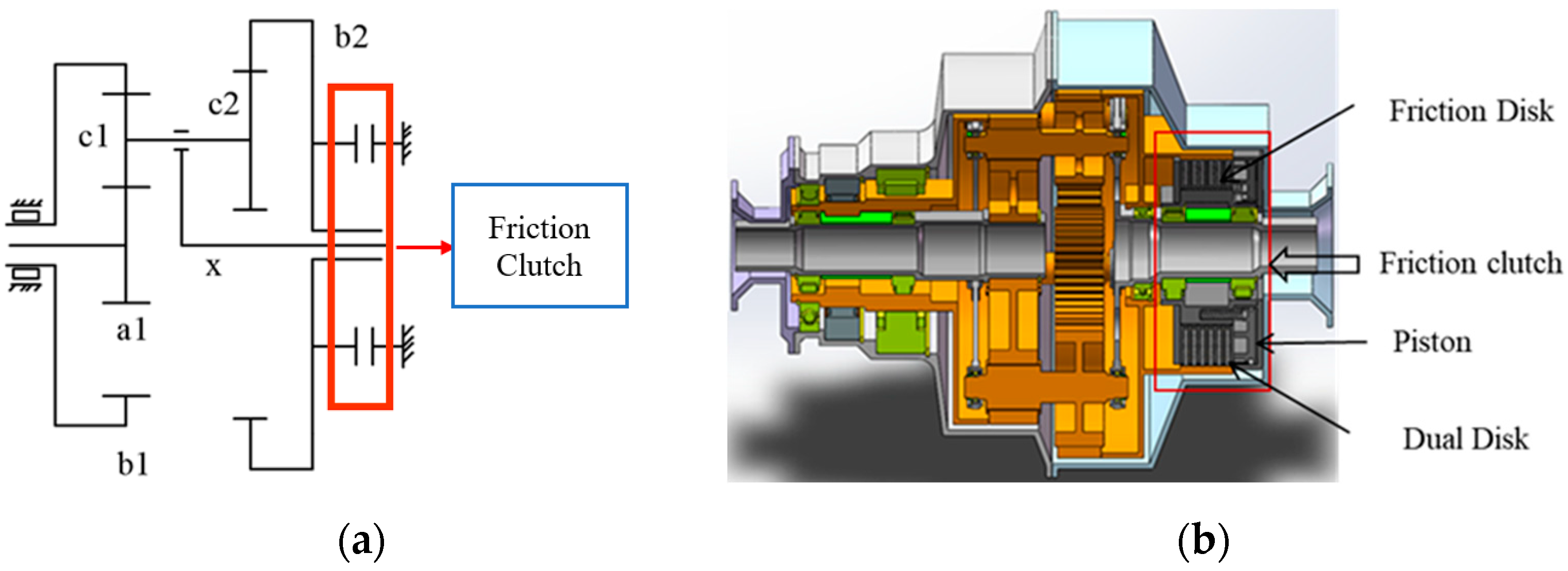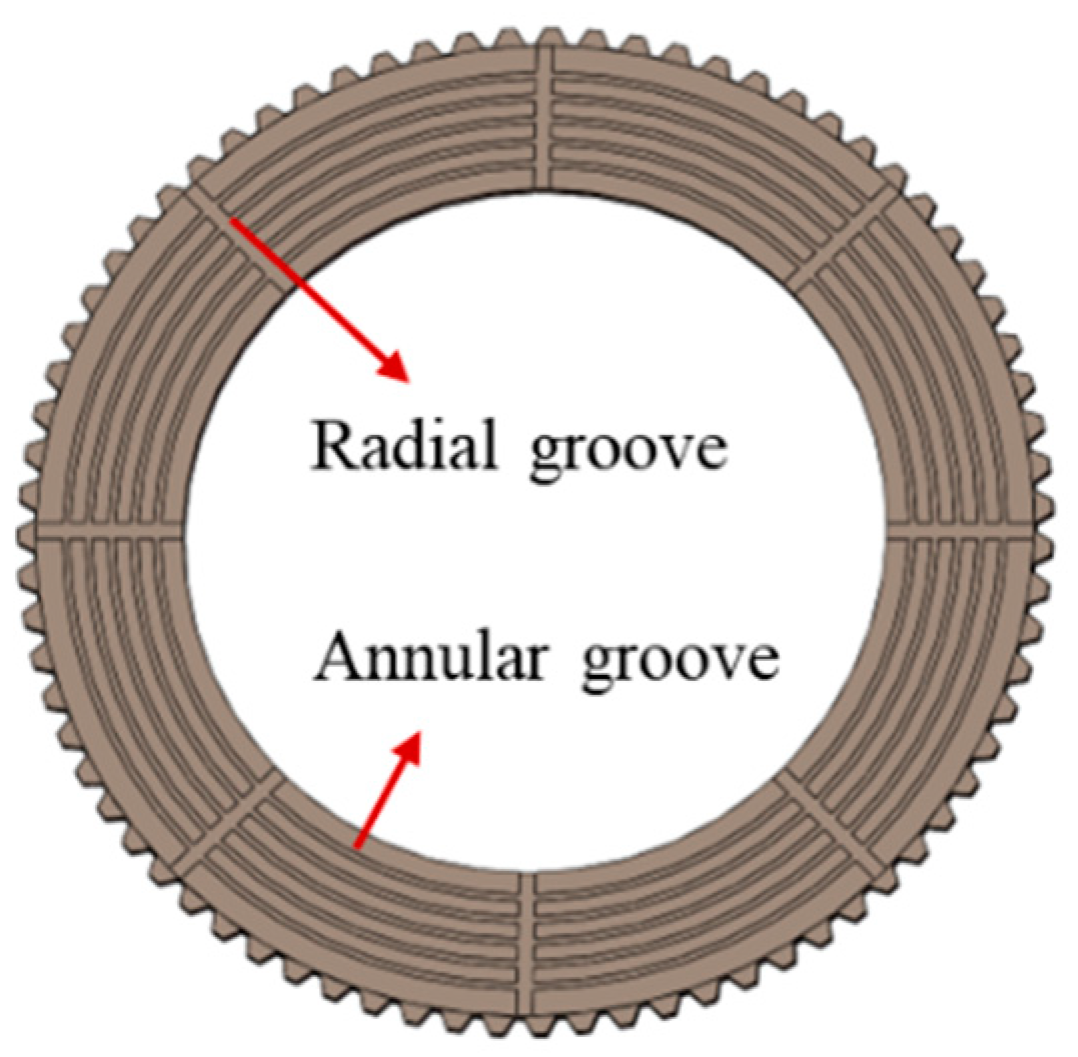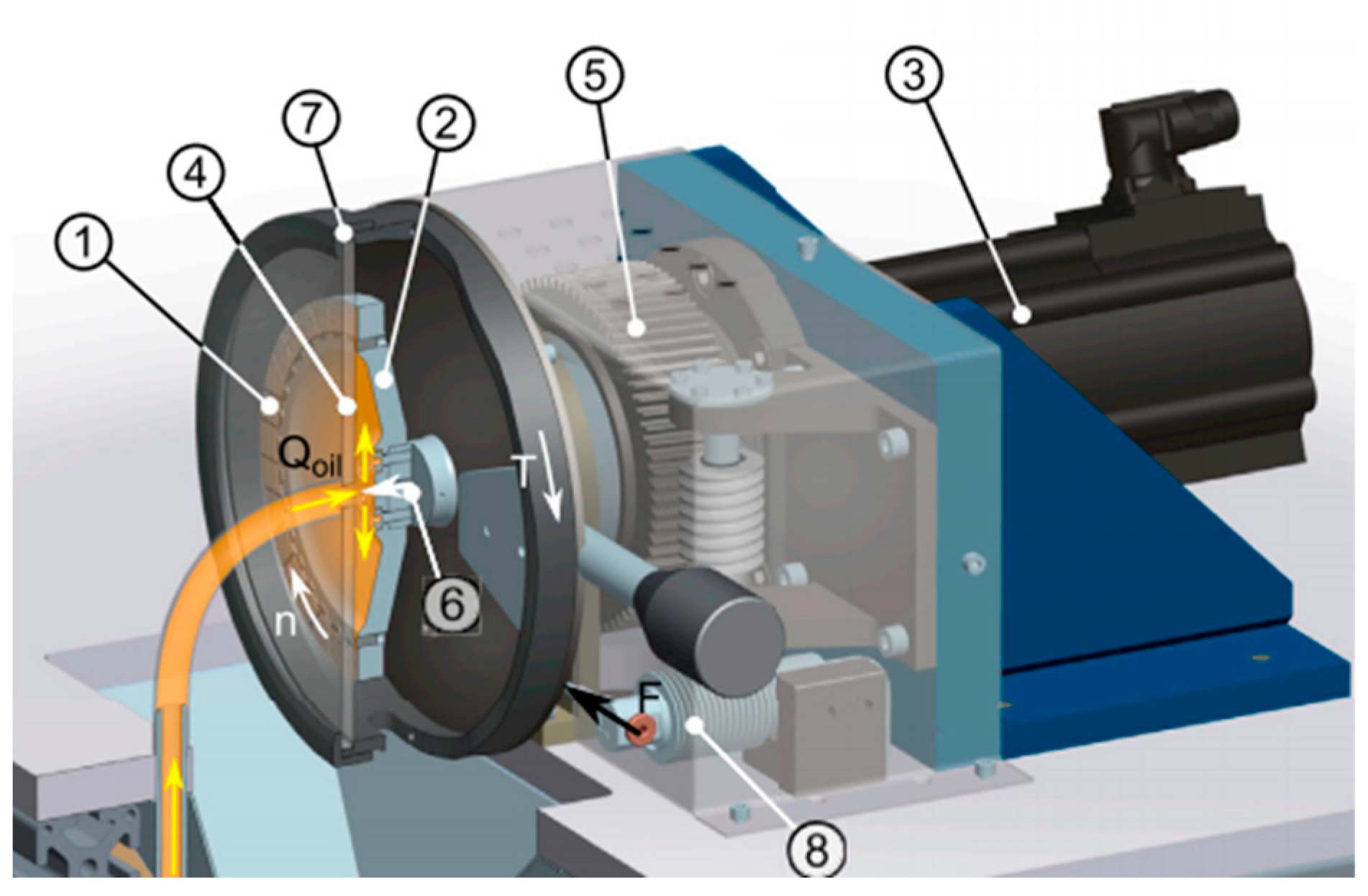2.2. Drag Torque Mathematical Model
The surface appearance of wet clutch friction disc is too complex and diverse to analyze directly, but the main working part of the clutch is the friction pair. Therefore, the main working part of the friction disc and the pair can be simplified, as shown in
Figure 2.
In
Figure 2, the pair is driven at a speed n and the friction disc is stationary. The wet clutch friction pair is regarded as two relative moving discs with a distance of δ, since the δ is generally small enough, the fluid between them can be assumed as a stratospheric flow [
16], and the speed of the fluid between the two discs can be considered as a linear change. The lubricant between the two forms shear stresses due to the relative motion of the dual and friction disc. Where, n is the rotation speed of drive disc. v is the speed difference between drive disc and driven disc.
The structure of wet friction clutch is complicated, but the main working part is composed of several friction pairs. Based on the analysis of a single friction pair, the simplified model of the friction pair is shown in
Figure 2. The torque produced by shear action in lubricating oil reservoir is called drag torque. When the wet clutch is idling, the friction plate and the dual plate separation is not complete and there will be friction or sliding, of which the shear effect is more serious, resulting in not completely separated. There is also a loss of energy. The clearance of friction pair is different in practice. The clearance in the middle is larger, while the clearance on both sides is smaller. The average clearance of the total length is taken as the calculation parameter in this model.
In
Figure 2, the pair is driven at a speed n and the friction disc is stationary. The wet clutch friction pair is regarded as two relative moving discs with a distance of δ, since the δ is generally small enough, Relative moving discs with a distance of δ, since the δ is generally small enough, the fluid between them can be regarded as a stratospheric flow, and the speed of the fluid between the two discs can be considered as a linear change. The lubricant between the two forms shear stresses due to the relative motion of the dual and friction disc.
Some grooves, including radial grooves and circumferential grooves, are designed on the surface of the friction plate of the wet friction clutch to ensure the flow of the lubricating oil film. It is necessary to consider the factor of groove to reveal the pressure distribution of friction pair clearance. Based on a single friction pair, the influence of radial groove and circumferential groove should be considered in the parametric model.
It is assumed that the lubricating oil between the friction plates is an incompressible fluid, the viscosity is constant, and the oil film is in an isothermal field. According to the theory of hydrodynamic lubrication, hydrodynamic and oil film shear forces are generated between the clutch plates. The complete analytical Laplace equation of these forces is:
where
p is the fluid pressure,
r is the radius of curvature, and
θ is the position angle.
The radial grooves and annular grooves of the friction disks are both rectangular grooves. As shown in
Figure 3, in order to simplify the calculation, it is approximately considered that the radial rectangular groove is a fan-shaped groove with an angle of
θ1, the thickness of the oil layer is
δ1, and the angle of the non-radial oil groove area is approximated.
θ2, in which the thickness of the oil layer in the non-oil groove area is
δ2, the thickness of the oil layer in the annular groove area is
δ3. According to the incompressibility and continuity of the lubricating oil, the pressure distribution in the
θ1 and
θ2 regions can be obtained as:
where
p1 is the highest pressure at the boundary line of the non-oil groove area of
θ1 and
θ2;
p2 is the highest pressure at the boundary line of the annular groove area of
θ1 and
θ2;
p0 is determined by boundary conditions;
μ is the dynamic viscosity of lubricating oil;
ω is the rotational speed of the dual plate.
Take the micro-units
dz,
dr, and
rdθ in the area
θ1, carry out the circumferential force analysis on the micro-unit body, and establish the equilibrium equation:
Due to the small thickness of the oil layer, the pressure of the oil layer in the z direction is considered to be constant. According to Newton’s law of internal friction, the internal friction force
τ = −
μ(
dv/
dz), where
dv/
dz is the velocity gradient. The known boundary conditions are the following: the rotational speed of the dual plate is
ω, and the rotational speed of the friction plate is 0 (z = 0,
v = 0; z =
δ1,
v =
rω). Therefore:
The oil layer shear stress is:
The drag torque due to shear stress is:
The drag torque in the region
θ1 is
The drag torque transmitted by the shearing of the oil layer at the
θ2 non-oil groove area
r is:
The drag torque in this annular area is:
where
ra1 and
ra2 are the inner and outer diameters of each annular region in the non-oil groove area of
θ2. Therefore, the drag torque in the non-oil groove area of
θ2 is:
The drag torque transmitted by the shearing of the oil layer at the annular groove region r of
θ2 is:
Then the drag torque in the circumferential groove is:
where
rb1 and
rb2 are the inner and outer diameters of each annular groove in the area of
θ2. Then, the drag torque in the annular groove area of
θ2 can be obtained as:
The drag torque transmitted by the clutch is totally:
2.3. Thermal-Fluid-Solid Coupling Simulation of Compound Oil Groove
At present, there are different types of oil grooves on the friction disc surface of wet friction clutch, among which single radial groove, annular groove, arc groove, and waffle groove are more common. The research shows that compared with the single oil groove, the radial-annular compound oil groove has lower temperature rise and stronger heat dissipation; compared with the double circular arc oil groove and waffle groove, the radial-annular compound oil groove can maintain the circumferential high-speed flow of oil, the maximum flow rate changes little, and the comprehensive performance is better [
14].
Figure 4 shows the structure of the friction disc that is radial-annular compound oil groove. In addition, the radial-annular compound oil groove has the advantages of good oil supply on the friction surface, good cooling effect, and large friction coefficient.
Table 1 shows the relevant working parameters of wet friction clutch. According to the heat flow coupling modeling theory of wet friction clutch, a single oil film is taken as the research object, and the geometric model of oil film is established according to the design parameters; the parameters of oil film in air loss stage can be obtained by establishing high quality grid for the model and combining the post-processing function of FLUENT ANSYS software 18.0; Software for Technical Computation; ANSYS: Pennsylvania, USA 2019.
Table 2 shows the working parameters of lubricating oil.
Figure 5 shows the simulation model meshing. The mesh of friction plate simulation model is divided in the form of unstructured mesh, and Poly-Hexcore volume mesh generation method is adopted. This mesh is superior to tetrahedron in simulation calculations. It is characterized by the unique hexahedral mesh and polyhedral mesh to achieve common node connection, and can increase the number of hexahedral mesh to achieve the purpose of improving the efficiency and accuracy of solving. The angle and the tip are refined.
As shown in the
Figure 6, the inlet boundary condition is mass inflow, with flow rate of 0.1 kg/s, and the outlet boundary condition is outflow. The oil layer surface is set as the wall surface, where the oil layer surface close to the active surface is the moving wall surface rotating at the working speed. The form of heat transfer between the oil layer, friction disc, and dual disc is convection.
The divided high-quality mesh was imported into FLUENT for calculation. The pressure—based solver is selected for the heat—flow coupling simulation analysis. The simulation focuses more on the result and adopts the steady-state calculation. The calculation model is SST k-ω model, which is used to predict the propagation rate of free shear flow, so it can be applied to wall bound flow and free shear flow. Complete pressure-velocity coupling can be achieved using the Coupled coupling algorithm. A heat flow coupling simulation model is established under viscous heating, incompressible heat dissipation, and convection heat dissipation.
Table 3 shows the drag torque and maximum temperature of group A and group B, which have different oil groove structure parameters.
m is the number of radial grooves,
b1 and
b2 are the width of radial and annular grooves, respectively,
l is the spacing between two annular grooves. The simulation results show that the drag torque of group A is smaller, but the temperature rise is higher. In group B, the number of oil grooves is increased, so the heat dissipation capacity is stronger, and the drag torque is larger.
Figure 7 illustrates the pressure distribution and temperature distribution of thermal-fluid-solid coupling simulation. Temperature distribution: the temperature of oil film in
Figure 3 shows concentric circular distribution, and with the increase in radius, the larger the line speed, the more heating of oil film, the higher the temperature; the temperature in the outer ring area is higher, and the heat dissipation effect is not good at this time, and the area where high temperature wear is most likely to occur.
Pressure distribution: it can be seen in
Figure 8 that the oil film is divided into several fan-shaped areas by radial groove, and the pressure is distributed symmetrically. The high-pressure area is mainly distributed in the outer ring; when the friction disc rotates in the anti-clockwise direction, the oil pressure in the sector area decreases in the anti-clockwise direction due to the strong oil scraping ability of the radial oil groove.























